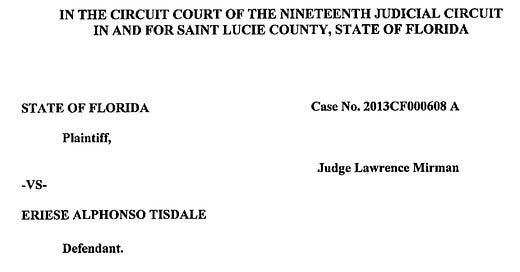St. Lucie County: Eriese Tisdale resentenced to death
In September 2024, a jury recommended a sentence of death by a vote of 9-3. This week, the trial court resentenced Tisdale to death.
Eriese Tisdale was originally sentenced to death for killing a law enforcement officer in 2013. Following the original penalty phase, in October 2015, the jury recommended death by a vote of 9-3. He was sentenced to death in January 2016 just before the U.S. Supreme Court decided Hurst.
On direct appeal in 2018, Tisdale was granted a new penalty phase in light of Hurst.1
In September 2024, after a new penalty phase, a jury recommended a sentence of death by a vote of 9-3. (More on that here. Note that this post has been updated to include the jury verdict form.)
This week, the trial court resentenced Tisdale to death.
In the Sentencing Order, the trial court merged the four aggravating factors into one for weighing purposes. As to statutory mitigation, the trial court found that two of the three proposed mitigating circumstances were not proven. The court did find that the defendant’s age the time of the crime was 25 and assigned it moderate weight.
As to nonstatutory mitigation, the trial court found:
Tisdale’s family was subject of a racially motivated arson attack (little weight);
Tisdale exhibits abnormal brain structure (little weight);
Tisdale’s mother was addicted to cocaine during her pregnancy (little weight);
Tisdale was raised by a single parent, who worked two jobs (very little weight);
Tisdale’s mother physically abused him by corporal punishment (extremely little weight);
Tisdale’s mother suffered from depression and had a repressive way of coping (very little weight);
Tisdale was an abnormal child who suffered from tremors (very little weight);
Tisdale suffered a panic attack and hyperventilation at the age of nine or ten (very little weight);
Tisdale’s uncle was an alcoholic (very little weight);
As a child, Tisdale lived in a neighborhood that “eventually morphed into a high crime, drug riddled neighborhood” (very little weight);
Tisdale’s friend was killed by an officer (very little weight);
The death of Tisdale’s friend affected Tisdale’s neighborhood (very little weight);
Tisdale’s friends traditionally armed themselves for self-defense (very little weight);
Tisdale’s close relative was murdered (moderate weight);
Tisdale lost several male role models (moderate weight);
Tisdale never received grief counseling for any of the losses he experienced (very little weight);
Tisdale’s murdered relative shared his negative police experiences with Tisdale (little weight);
Tisdale started using marijuana at the age of 14 and was addicted (little weight);
Tisdale’s marijuana use affected his brain chemistry (very little weight);
Tisdale has an 11-year-old son to whom he speaks and gives guidance (moderate weight);
Tisdale is smart and earned an advanced degree in architectural drafting with a 3.0 GPA (little weight);
Tisdale suffered a disturbed trajectory (little weight);
Tisdale saw racism in school (very little weight);
Tisdale has a sense of humor and is the family comedian (little weight);
Tisdale has a history of suffering from anxiety (little weight);
At the time of the murder, Tisdale was “overwhelmed by anxiety” (little weight);
Tisdale suffered traumatic events and suffered their effects (very little weight);
Tisdale has been a model prisoner and would do well in general confinement (moderate weight);
Tisdale’s mother’s parenting style created anxiety in him by teaching him to be fearful (very little weight);
Tisdale was afraid of police on the day of the crime (extremely little weight);
Tisdale suffered from an untreated heart problem (extremely little weight);
Tisdale lacked a steady father figure (little weight);
Tisdale exhibited erratic behavior in childhood that is corroborated by the brain imagine (appropriate weight);
Tisdale’s relatives exposed Tisdale to marijuana use (little weight);
Tisdale was the victim of domestic violence at the hands of his mother’s one-time boyfriend (little weight);
Tisdale witnessed an act of domestic violence (very little weight);
Tisdale’s family and environment involved constant reaffirmation of fear and danger (very little weight);
Tisdale’s family loves him;
Tisdale was involved in church activities as a child and was “well mannered” when attending (little weight); and
Tisdale was under a false impression regarding the identity of his biological father (very little weight).
Further, the court determined the following were not proven:
Tisdale was born addicted to cocaine or suffered withdrawal symptoms;
Tisdale had prior negative experiences with police;
Prior confrontations with police instilled fear in Tisdale;
Tisdale’s brain is damaged such that he lives in constant fear;
Tisdale’s mother’s use of cocaine led to Tisdale’s marijuana addiction;
Tisdale exhibited erratic behavior in childhood that is corroborated by the brain imaging; and
Tisdale has expressed sincere remorse.
The full Sentencing Order can be downloaded here.




